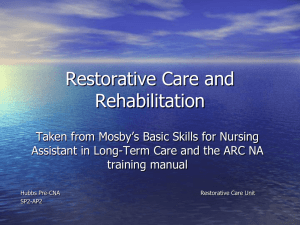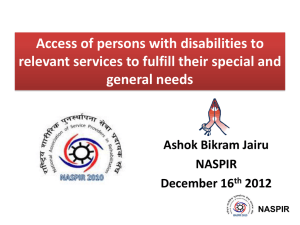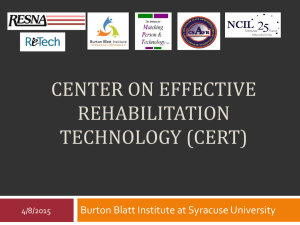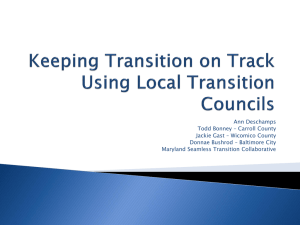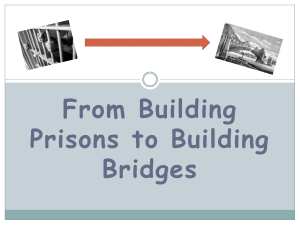csavr wia language - Council of State Administrators of Vocational
advertisement
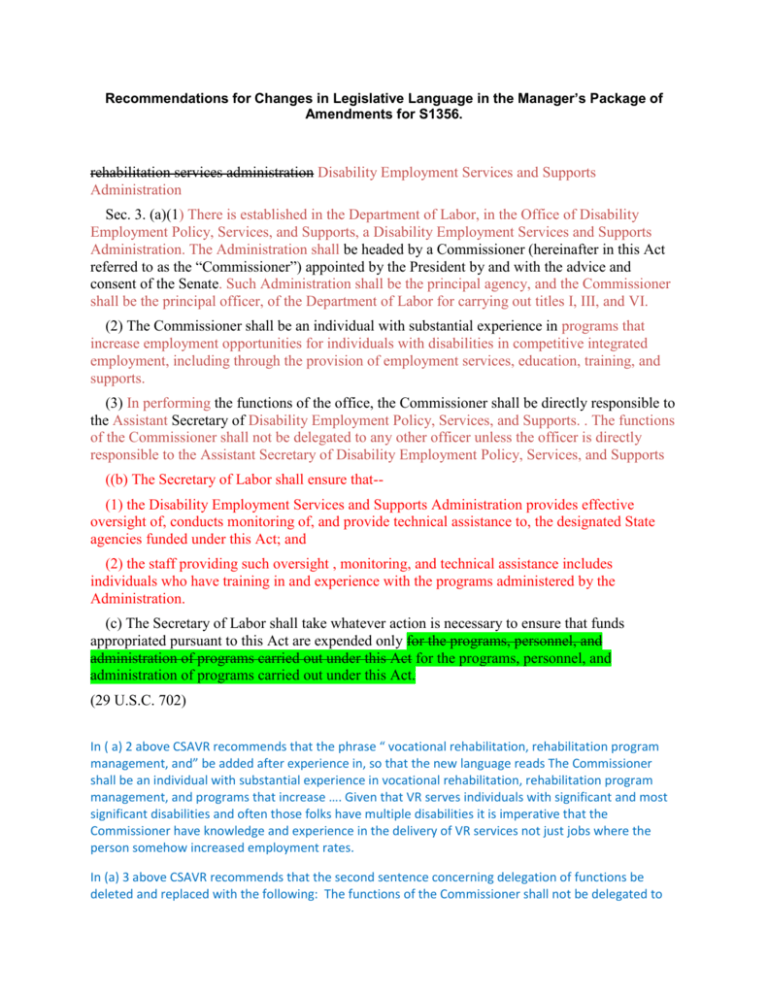
Recommendations for Changes in Legislative Language in the Manager’s Package of Amendments for S1356. rehabilitation services administration Disability Employment Services and Supports Administration Sec. 3. (a)(1) There is established in the Department of Labor, in the Office of Disability Employment Policy, Services, and Supports, a Disability Employment Services and Supports Administration. The Administration shall be headed by a Commissioner (hereinafter in this Act referred to as the “Commissioner”) appointed by the President by and with the advice and consent of the Senate. Such Administration shall be the principal agency, and the Commissioner shall be the principal officer, of the Department of Labor for carrying out titles I, III, and VI. (2) The Commissioner shall be an individual with substantial experience in programs that increase employment opportunities for individuals with disabilities in competitive integrated employment, including through the provision of employment services, education, training, and supports. (3) In performing the functions of the office, the Commissioner shall be directly responsible to the Assistant Secretary of Disability Employment Policy, Services, and Supports. . The functions of the Commissioner shall not be delegated to any other officer unless the officer is directly responsible to the Assistant Secretary of Disability Employment Policy, Services, and Supports ((b) The Secretary of Labor shall ensure that-(1) the Disability Employment Services and Supports Administration provides effective oversight of, conducts monitoring of, and provide technical assistance to, the designated State agencies funded under this Act; and (2) the staff providing such oversight , monitoring, and technical assistance includes individuals who have training in and experience with the programs administered by the Administration. (c) The Secretary of Labor shall take whatever action is necessary to ensure that funds appropriated pursuant to this Act are expended only for the programs, personnel, and administration of programs carried out under this Act for the programs, personnel, and administration of programs carried out under this Act. (29 U.S.C. 702) In ( a) 2 above CSAVR recommends that the phrase “ vocational rehabilitation, rehabilitation program management, and” be added after experience in, so that the new language reads The Commissioner shall be an individual with substantial experience in vocational rehabilitation, rehabilitation program management, and programs that increase …. Given that VR serves individuals with significant and most significant disabilities and often those folks have multiple disabilities it is imperative that the Commissioner have knowledge and experience in the delivery of VR services not just jobs where the person somehow increased employment rates. In (a) 3 above CSAVR recommends that the second sentence concerning delegation of functions be deleted and replaced with the following: The functions of the Commissioner shall not be delegated to any officer who is not directly responsible, both with respect to program operation and administration, to the Commissioner. In (b) 2 above CSAVR recommends that at the end of the section add the phrase: and the delivery of vocational rehabilitation services under the Rehabilitation Act of 1973 as amended. In ( c) above CSAVR recommends that after The Secretary of Labor the following be added: working in concert with the Commissioner so the new language reads The Secretary of Labor working in concert with the Commissioner shall take …. This language reinforces the statements that have been made by both Senator Harkin’s and Alexander’s Offices that the Secretary of the Department where the VR program is housed needs to be aware of and involved in the VR program and having this stated tie between the Commissioner and Secretary ensures this Secretarial support. Section 3(a)2 under the Disability Employment Services and Supports Administration in the Bipartisan Draft defines the RSA Commissioners Position as stated below. (2) The Commissioner shall be an individual with substantial experience in programs that increase employment opportunities for individuals with disabilities in competitive integrated employment, including through the provision of employment services, education, training, and supports. CSAVR recommends that the word rehabilitation be added after the word provision, so that the new language reads The Commissioner……, including through the provision of rehabilitation and employment services…..supports. We are adding the term rehabilitation. Definition of Pre-Employment Transition Services Page 22 in the red line draft (30) define pre-employment transition services as stated below. (30) PRE-EMPLOYMENT TRANSITION SERVICES.(A) IN GENERAL.-The term ‘pre-employment transition services’ means a coordinated set of activities for a student with a disability who is eligible or potentially eligible for services under Title I, designed within an outcomeoriented process, that promotes movement from school to post-school activities, including postsecondary education, vocational training, competitive integrated employment (including supported employment), adult education, adult services, independent living, or community participation. (B) SPECIFIC SERVICES.-The term ‘pre-employment transition services’ means a set of services, that is available to students with disabilities who are eligible or potentially eligible for services under title I, and that make available, at a minimum(i) job exploration counseling; (ii) work-based learning experience, such as in-school or after school work experience, or work experience outside the traditional school setting (such as experience through job training or internships), that is provided in an integrated environment to the maximum extent possible; (iii) counseling on opportunities for enrollment in a comprehensive transition or postsecondary educational program at an institution of higher education; (iv) school-based preparatory employment experiences such as role playing, social skills development, and independent living training, coordinated with any transition services provided by the local educational agency under the Individuals with Disabilities Education Act (20 U.S.C. 1400 et. seq.); and (v) instruction in self-advocacy, individual rights, self-determination skills, and the informed consent process, as well as peer mentoring. (C) COORDINATED SET OF ACTIVITIES.- For purposes of subparagraph (A), the coordinated set of activities shall be provided in a manner that leverages appropriate resources and services available outside the vocational rehabilitation program described in title I and shall be based on the individual needs of a student with a disability, taking into account the student’s preferences and interests, and shall include education and training, community experiences, the development of employment and other adult living objectives, and, when appropriate, acquisition of daily living skills and functional vocational evaluation. CSAVR recommends under (B) Specific Services the following language. The term preemployment transition services means ………and that make available, based on the individual student’s needs. We are changing the language at a minimum to language based on the individual student’s needs, because the VR program is based on individualized services and supports and every student does not or will not need the same set of services to be successful in employment. We are also recommending that B (i) be changed to career exploration as opposed to job exploration. This change in the definition supports and mirrors the description of how the coordinated set of activities is defined – “based on the individual needs of the student. Under the coordinated set of activities For purposes of subparagraph (A) the coordinated set of activities………taking into account the student’s preferences and interests and may instead of shall….vocational evaluation. Again keeping the focus on providing services based on the individual student’s needs. Page 49 – Reporting Requirements – The CSAVR does not have specific language on the reporting requirements, but again reiterate our concerns related to the costs to states for the extensive additional data collection requirements and analysis. SEC. 114. PROVISION OF PRE-EMPLOYMENT TRANSITION SERVICES. (a) IN GENERAL.-- From the funds reserved under section 110(d), and funds made available through other funding sources, each State shall ensure that the designated State unit, in collaboration with the local educational agencies involved and other appropriate entities, shall provide, or arrange for the provision of, pre-employment transition services. (b) LOCAL PRE-EMPLOYMENT TRANSITION COORDINATOR.-(1) COORDINATOR.-Each local office of a designated State unit shall designate staff to carry out the responsibilities of Local Pre-Employment Transition Coordinators for the local office, as well as appropriate staff to support the Coordinators in carrying out the responsibilities described in paragraph (2). (2) RESPONSIBILITIES.-It shall be the responsibility of a Local Pre-Employment Transition Coordinator to(A) attend individualized education program meetings for students with disabilities, when invited; (B) work with the local workforce development boards, one-stop centers, and employers to develop job opportunities for students with disabilities, including internships, summer employment opportunities and other employment opportunities available throughout the school year, and apprenticeships; and (C) work with schools, including those carrying out activities under section 614(d)(1)(A)(i)(VIII) of the Individuals with Disabilities Education Act (20 U.S.C. 1414(d)(1)(A)(i)(VIII), to coordinate and ensure the provision of preemployment transition services for students with disabilities, including services described in clauses (i) through (v) of section 7(30)(B). CSAVR recommends that the language in Section 114 (b) Local Pre-Employment Transition Coordinator be changed as follows. (1) Each state unit must designate sufficient staff statewide, consistent with their approved State Plan, to carry out the responsibilities of the local Pre-employment Transition Coordinators and the support staff necessary to assist the Transition Coordinators in carrying out the responsibilities described in paragraph (2). B (2) Responsibilities (A) CSAVR recommends changing attend to participate in. Rationale – The states must have some flexibility in determining the number of staff necessary to work with transition students in individual states and to assign staff to meet the needs identified during the public hearing process to develop the State Plan. Every office will not need a transition coordinator, as some offices are very small and a transition coordinator would be able to cover more than one office. Also staffing issues may not allow for the provision of this position in every office. In states that are unionized, contractual provisions regarding positions and duties of VR Counselors would have to be followed and may create some challenges to implementing the proposed changes in the law. Under responsibilities (A) recommend changing when invited … to when provided reasonable advanced notification CSAVR also recommends that IDEA be amended to include a similar provision requiring the public schools to provide VR with sufficient notification of IEP meetings. Under (B) CSAVR recommends adding the National Employment Team or The NET Business Consultants to the list of partners with whom the local transition coordinators will work. Page 37 and 142 speak to the attainment of “high quality” employment outcomes. This description is open to individual interpretation. CSAVR recommends that the determining factor regarding the quality of the employment outcome should be competitive integrated employment, consistent with the individual’s skills, interests, abilities and informed choice and that “high quality employment” be defined accordingly. SEC. 623. AVAILABILITY OF SERVICES. (a) SUPPORTED EMPLOYMENT SERVICES.-Funds provided under this part may be used to provide supported employment services to individuals who are eligible under this part. (b) EXTENDED SERVICES.(1) IN GENERAL -- Except as provided in paragraph (c), funds Funds provided under this part, or title I, may not be used to provide extended services to individuals who are eligible under this part or title I. (2) EXTENDED SERVICES FOR YOUTH WITH THE MOST SIGNIFICANT DISABILITIES – Funds allotted under this part, or title I, and used for the provision of services under this part to youth with the most significant disabilities pursuant to section 622(d), may be used to provide extended services to youth with the most significant disabilities for a period not to exceed 4 years. (29 U.S.C. 795i) CSAVR supported the increase in the provision of supported employment services from 18 months up to 24 months. However, we strongly oppose the provision of up to 48 months of extended services for youth with the most significant disabilities. In reality this would allow up to 6 years of services for each individual student and state VR agencies do not have the staff or fiscal resources to potentially provide this level of service to each student. S 1356 also requires that supported employment funding be matched and this new requirement will have a significant negative impact on some states that will not be able to provide the matching funds. The unintended consequence of this change is the potential decrease in the provision of this service as opposed to the increase which is expected based on the proposed change in the law. CSAVR also believes it is imperative that we not shift the burden of the provision of extended services and supports to State VR Agencies and allow others who have had this responsibility, based on current law, to not be accountable for this service. CSAVR recommends language in SEC. 623. Availability of Services be changed as follows. EXTENDED SERVICES FOR YOUTH WITH THE MOST SIGNIFICANT DISABILITIESfunds allotted………622 (d) may be used in combination with funding from other sources to provide extended services to youth with the most significant disabilities as appropriate to determine if the individual student is capable of achieving a competitive employment outcome in an integrated setting. Youth with the most significant disabilities who are eligible for funding for extended services from another funding source must have this source of funding included as a comparable service and benefit as defined in S1356, and noted in the Individualized Plan for Employment (IPE). Proposed Language (7) COMPREHENSIVE SYSTEM OF PERSONNEL DEVELOPMENT.—The State plan shall— (A) include a description (consistent with the purposes of this Act) of a comprehensive system of personnel development, which shall include— (i) a description of the procedures and activities the designated State agency will undertake to ensure an adequate supply of qualified State rehabilitation professionals and paraprofessionals for the designated State unit, including the development and maintenance of a system for determining, on an annual basis— (I) the number and type of personnel that are employed by the designated State unit in the provision of vocational rehabilitation services, including ratios of qualified vocational rehabilitation counselors to clients; and (II) the number and type of personnel needed by the State, and a projection of the numbers of such personnel that will be needed in 5 years, based on projections of the number of individuals to be served, the number of such personnel who are expected to retire or leave the vocational rehabilitation field, and other relevant factors; (ii) where appropriate, a description of the manner in which activities will be undertaken under this section to coordinate the system of personnel development with personnel development activities under the Individuals with Disabilities Education Act (20 U.S.C. 1400 et seq.); (iii) a description of the development and maintenance of a system of determining, on an annual basis, information on the programs of institutions of higher education within the State that are preparing rehabilitation professionals, including— (I) the numbers of students enrolled in such programs; and (II) the number of such students who graduated with certification or licensure, or with credentials to qualify for certification or licensure, as a rehabilitation professional during the past year; (iv) a description of the development, updating, and implementation of a plan that— (I) will address the current and projected vocational rehabilitation services personnel training needs for the designated State unit; and (II) provides for the coordination and facilitation of efforts between the designated State unit, institutions of higher education, and professional associations to recruit, prepare, and retain qualified personnel, including personnel from minority backgrounds, and personnel who are individuals with disabilities; and (v) a description of the procedures and activities the designated State agency will undertake to ensure that all personnel employed by the designated State unit are appropriately and adequately trained and prepared, including— (I) a system for the continuing education of rehabilitation professionals and paraprofessionals within the designated State unit, particularly with respect to rehabilitation technology, including training implemented in coordination with entities carrying out State programs under section 4 of the Assistive Technology Act of 1998 (29 U.S.C. 3003); and (II) procedures for acquiring and disseminating to rehabilitation professionals and paraprofessionals within the designated State unit significant knowledge from research and other sources, including procedures for providing training regarding the amendments to this Act made by the Workforce Investment Act of 2013; (B) set forth policies and procedures relating to the establishment and maintenance of standards to ensure that personnel, including rehabilitation professionals and paraprofessionals, needed within the designated State unit to carry out this part are appropriately and adequately prepared and trained, including— (i) the establishment and maintenance of standards that are consistent with any national or State approved or recognized certification, licensing, registration, or other comparable requirements that apply to the area in which such personnel are providing vocational rehabilitation services; and (ii) to the extent that such standards are not based on the highest requirements in the State applicable to a specific profession or discipline, the steps the State is taking to require the retraining or hiring of personnel within the designated State unit that meet appropriate professional requirements in the State; and (ii) to the extent that such standards are not based on the highest requirements in the State applicable to a specific profession or discipline, the steps the State is taking to require the retraining or hiring of personnel within the designated State unit that meet appropriate professional requirements in the State; and the establishment and maintenance of education and experience requirements, to ensure that personnel have an understanding of vocational rehabilitation which includes the medical aspects of disability, vocational assessment, planning and services required to develop a holistic and comprehensive individualized career plan with the VR customer, that enables the person to be successfully employed. This must include a working knowledge of the 21st Century labor force at the national, state and local level, coupled with the ability to develop relationships with business, that enable the VR employee to have an understanding of the employment needs of business in the public and private sectors, and deliver services that support the success of the employer-employee relationship. (II) attainment of a master’s or doctoral degree in a field of study such as vocational rehabilitation counseling, law, social work, psychology, disability studies, business administration, human resources, special education, management, public administration, or another field that reasonably provides competence in the employment sector, in a disability field, or in both businessrelated and rehabilitation-related fields. (D) contain provisions relating to the establishment and maintenance of minimum standards to ensure the availability of personnel within the designated State unit, to the maximum extent feasible, trained to communicate in the native language or mode of communication of an applicant or eligible individual. Section 110 State Allotments (b)(4) For the purposes of this part, any portion made available to a State for any fiscal year pursuant to this subsection shall be regarded as an increase of such State’s allotment (as determined under the preceding provisions of this section) for such year. CSAVR recommends that new Section b4 be amended to insert the word “not” after pursuant to this subsection shall so the revised section reads: For the purposes of this part, any portion made available to a State for any fiscal year pursuant to this section shall not be regarded as an increase of such State’s allotment (as determined under the preceding provisions of this section) for such year. Such a change will eliminate the disincentive that currently exists for states going after reallotment dollars and ensure more dollars and thus services in the states to serve individuals with disabilities especially transition youth. Section 19 Carryover SEC. 19. CARRYOVER. (a) IN GENERAL.—Except as provided in subsection (b), and notwithstanding any other provision of law— (1) any funds appropriated for a fiscal year to carry out any grant program under part B of title I (except for the client assistance program funded under section 112), part B of Title VI, chapter 1 of title VII, or chapter 2 of title VII (except as provided in section 753(b)), including any funds reallotted under any such grant program, that are not obligated and expended by recipients prior to the beginning of the succeeding fiscal year; or (2) any amounts of program income, including reimbursement payments under the Social Security Act (42 U.S.C. 301 et seq.), received by recipients under any grant program specified in paragraph (1) that are not obligated and expended by recipients prior to the beginning of the fiscal year succeeding the fiscal year in which such amounts were received, shall remain available for obligation and expenditure by such recipients during such succeeding fiscal year. (b) NON-FEDERAL SHARE.—Such funds shall remain available for obligation and expenditure by a recipient as provided in subsection (a) only to the extent that the recipient complied with any Federal share requirements applicable to the program for the fiscal year for which the funds were appropriated. CSAVR recommends that Section a2 above be expanded to add at the end of the proposed section the following language: and program income does not have to be expended by states prior to drawing down federal funds from their 110 allotment. This added language will clarify what has been practice and also again ensure more funds being available for case services and reduce the administrative burden on VR agencies. Referrals from Disability Determination Services (DDSs) Many DDSs are located in state VR agencies. Prior to the adoption of HIPPA in the aforementioned instances the DDSs were notifying VR when they were recommending that an applicant was not eligible for SSI/SSDI benefits so that VR could contact the person and get them involved in VR and return to work quickly. HIPPA shut this door. CSAVR recommends this bill include a provision amending HIPPA to allow the exchange of personal identifying information between DDSs and VR agencies when ineligibility is being recommended by the DDS to give individuals greater opportunity to return to work more quickly.
